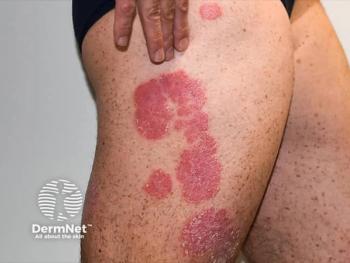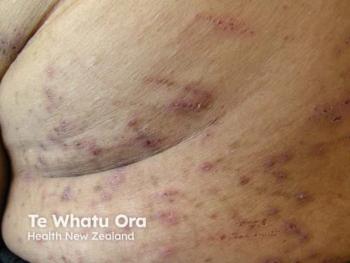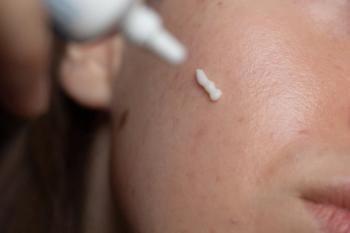
Dual Inhibitor TRIV-509 Shows Promise for Rapid Improvement in Atopic Dermatitis
Key Takeaways
- TRIV-509 targets KLK5 and KLK7, reducing epidermal hyperplasia and keratinocyte proliferation in atopic dermatitis.
- Treatment with TRIV-509 restores DSG1 expression, improving cell-cell adhesion and skin barrier integrity.
Researchers reveal TRIV-509, a novel monoclonal antibody, shows promise in rapidly improving atopic dermatitis by restoring skin barrier integrity and reducing inflammation.
At the recent Society for Investigative Dermatology (SID) 2025 Annual Meeting, researchers shared new data demonstrating that TRIV-509, a novel monoclonal antibody targeting the serine proteases KLK5 and KLK7, may offer a rapid and effective therapeutic approach for atopic dermatitis (AD).1 The findings, which were presented in a poster, highlight a promising avenue for restoring skin barrier integrity and reducing inflammation in patients.
Background and Methods
Increasing evidence links dysregulation of epidermal serine proteases to the pathogenesis of AD, with KLK5 and KLK7, or kallikrein-related peptidases, playing pivotal roles.2 These enzymes are typically involved in skin desquamation but are overexpressed and hyperactive in atopic skin, leading to excessive degradation of critical barrier proteins such as DSG1 and other structural components.2 Furthermore, variations that lead to increased KLK activity correlate with heightened susceptibility to AD and asthma.3
The investigation involved collecting skin biopsies from 3 patients with clinically diagnosed AD, characterized by an Investigator Global Assessment score greater than 2, indicative of moderate to severe disease activity. The experimental setup involved treating these biopsies with TRIV-509 or control IgG ex vivo.
The biopsies underwent treatment with 25 µg/mL of TRIV-509 for a period of 72 hours, with media changed at 48 hours and treatment renewed for an additional 24 hours. Subsequently, the tissues were processed for various analyses, including histological staining and immunohistochemistry, to assess changes in epidermal thickness, keratinocyte proliferation, and the expression of key structural proteins like DSG1.
Findings
One of the primary outcomes was a significant decrease in epidermal hyperplasia. In 2 patients, treatment with TRIV-509 resulted in a 14% to 28% reduction in epidermal thickness compared with control IgG.
This reduction correlated with diminished keratinocyte proliferation, demonstrated by an approximately 80% decrease in Ki-67–positive basal layer cells, highlighting a substantial decrease in epidermal hyperproliferation.
TRIV-509 effectively mitigated parakeratosis, reducing abnormal nuclei layers in the stratum corneum by 31% in 1 of the patients. Additionally, histological evaluation revealed that the treatment restored the distribution and expression of DSG1 with a notable increase of up to 313% in DSG1+ cell counts in treated specimens. This suggests a rapid reestablishment of cell-cell adhesion and barrier function.
Further analyses demonstrated that TRIV-509 increased DSG1 expression in the epidermis, aligning it more closely with nonlesional skin. The treatment also reduced epidermal thickness and parakeratosis substantially, indicating improved epidermal differentiation and barrier integrity.
Conclusions
The findings presented at SID suggest that targeting KLK5 and KLK7 with an antibody such as TRIV-509 can rapidly reverse key features of the atopic epidermal phenotype. The therapy not only reduced hyperproliferation and keratinocyte turnover but also directly improved barrier integrity by restoring DSG1 levels.
Moving forward, researchers plan to evaluate TRIV-509 in clinical trials, with a focus on skin barrier improvements, symptom alleviation, and quality-of-life outcomes for patients with AD. The data also encourage further exploration into protease-targeted therapies for other barrier-related skin conditions.
References
- Mateer E, Asp E, e Sousa MS, et al. TRIV-509, a dual inhibitor of KLK5 and KLK7, rapidly improves barrier integrity and markers of epidermal differentiation in atopic dermatitis skin explants. Poster presented at: Society for Investigative Dermatology Annual Meeting; May 7-10, 2025; San Diego, CA.
- Kishibe M. Physiological and pathological roles of kallikrein-related peptidases in the epidermis. J Dermatol Sci. 2019;96(3):135-143.
doi:10.1016/j.jdermsci.2019.06.007 - Elias PM. Therapeutic implications of a barrier-based pathogenesis of atopic dermatitis. Ann Dermatol. 2010;22(3):245-254.
doi:10.5021/ad.2010.22.3.245
Newsletter
Like what you’re reading? Subscribe to Dermatology Times for weekly updates on therapies, innovations, and real-world practice tips.


















